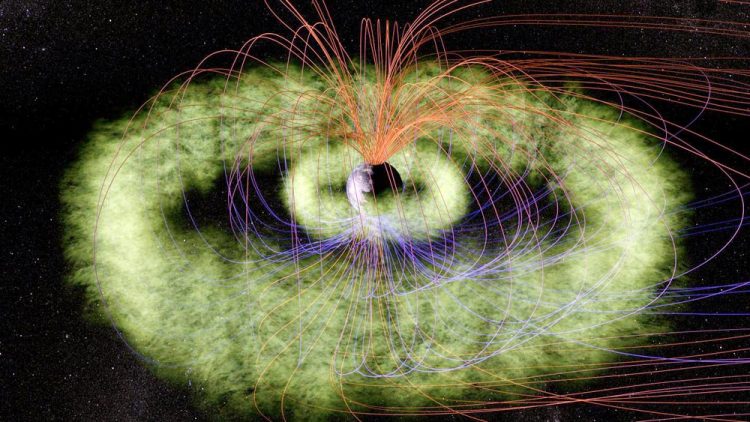FIREBIRD II and NASA mission locate whistling space electrons' origins

The Van Allen Belts, shown in green in this illustration, are concentric doughnut-shaped belts filled with charged particles, trapped by Earth's magnetic field. Credit: Tony Phillips/NASA
New research using data from NASA's Van Allen Probes mission and FIREBIRD II CubeSat has shown that a common plasma wave in space is likely responsible for the impulsive loss of high-energy electrons into Earth's atmosphere.
Known as whistler mode chorus, these waves are created by fluctuating electric and magnetic fields. The waves have characteristic rising tones — reminiscent of the sounds of chirping birds — and are able to efficiently accelerate electrons. The results have been published in a paper in Geophysical Review Letters.
“Observing the detailed chain of events between chorus waves and electrons requires a conjunction between two or more satellites,” said Aaron Breneman, researcher at the University of Minnesota in Minneapolis, and lead author on the paper. “There are certain things you can't learn by having only one satellite — you need simultaneous observations at different locations.”
The study combined data from FIREBIRD II, which cruises at a height of 310 miles above Earth, and from one of the two Van Allen Probes, which travel in a wide orbit high above the planet. From different vantage points, they could gain a better understanding of the chain of cause and effect of the loss of these high-energy electrons.
Far from being an empty void, the space around Earth is a jungle of invisible fields and tiny particles. It's draped with twisted magnetic field lines and swooping electrons and ions. Dictating the movements of these particles, Earth's magnetic environment traps electrons and ions in concentric belts encircling the planet. These belts, called the Van Allen Radiation Belts, keep most of the high-energy particles at bay.
Sometimes however, the particles escape, careening down into the atmosphere. Typically, there is a slow drizzle of escaping electrons, but occasionally impulsive bunches of particles, called microbursts, are scattered out of the belts.
Late on Jan. 20, 2016, the Van Allen Probes observed chorus waves from its lofty vantage point and immediately after, FIREBIRD II saw microbursts. The new results confirm that the chorus waves play an important role in controlling the loss of energetic electrons — one extra piece of the puzzle to understand how high-energy electrons are hurled so violently from the radiation belts. This information can additionally help further improve space weather predictions.
Media Contact
All latest news from the category: Physics and Astronomy
This area deals with the fundamental laws and building blocks of nature and how they interact, the properties and the behavior of matter, and research into space and time and their structures.
innovations-report provides in-depth reports and articles on subjects such as astrophysics, laser technologies, nuclear, quantum, particle and solid-state physics, nanotechnologies, planetary research and findings (Mars, Venus) and developments related to the Hubble Telescope.
Newest articles

A universal framework for spatial biology
SpatialData is a freely accessible tool to unify and integrate data from different omics technologies accounting for spatial information, which can provide holistic insights into health and disease. Biological processes…

How complex biological processes arise
A $20 million grant from the U.S. National Science Foundation (NSF) will support the establishment and operation of the National Synthesis Center for Emergence in the Molecular and Cellular Sciences (NCEMS) at…

Airborne single-photon lidar system achieves high-resolution 3D imaging
Compact, low-power system opens doors for photon-efficient drone and satellite-based environmental monitoring and mapping. Researchers have developed a compact and lightweight single-photon airborne lidar system that can acquire high-resolution 3D…





















